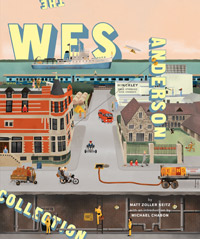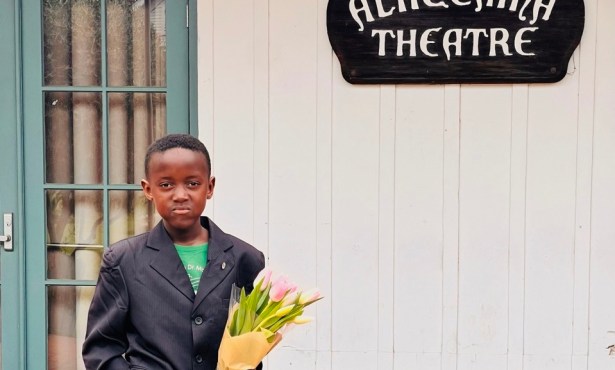Collecting Wes Anderson with Matt Zoller Seitz
The New York Magazine Critic Brings New Book to Life

For film geeks, music buffs, and Bill Murray fans, few things compare to the release of a new Wes Anderson film. In the 13 years since his Bottle Rocket hit the big screen, the Texas-born writer/director has been meticulously crafting film after film, building a repertoire and style that is unequivocally Andersonian. On the visual front, his movies look and feel like tiny works of art, painstakingly detailed, brightly colored, and perfectly encapsulated in their director’s frame. The scripts are dry, witty, and almost music-like in their pacing. And the songs — oh the songs — run the gamut from British invasion rock (Rushmore) to Portuguese takes on David Bowie classics (The Life Aquatic with Steve Zissou) and are all flanked by Mark Mothersbaugh’s tweeful original scores.
This March, Anderson unveils his eighth film, The Grand Budapest Hotel, and in advance of the release, Abrams Books has released an ode to Anderson of their own. Like the films it chronicles, The Wes Anderson Collection is a dense and stylized anthology — part coffee-table book and part scrapbook-style art project. Written by New York Magazine critic and longtime Anderson friend Matt Zoller Seitz, it dissects the director’s films one by one and pairs all the pictures, movie posters, and illustrations with a lengthy interview about each. This weekend, Seitz comes to town to discuss and sign his Collection. Recently, we talked with the author about movies, writing, and why he holds Anderson’s films so close to his heart.

You’ve known Wes for two decades. What prompted the idea for a book? Well, my editor at Abrams called me in fall of 2009 and said he had seen a series of video essays that I had done called “The Substance of Style,” in which I was analyzing the style of Wes Anderson, and he wanted to know if there was any way to turn that into a book, so that was the impetus. The idea of bringing in Wes and building a book around a book-length interview with Wes came later. The original idea was to take this analytical series of film-style videos and somehow turn it into a coffee table book.
Was Wes on board with the project from the get-go? Not really. It took about a year to sort of put all the pieces together in terms of contracts and rights and all that business. There was also an element of reluctance on his part because, while he’s proud of his work, he doesn’t like to toot his own horn. He didn’t want to be seen as actively participating in the creation of his own myth. He made it very clear from the beginning that I was the author and he was the subject. There was never any confusion about that.
How is he as an interview subject? He’s great. As long as you confine yourself to aesthetics and the details of the production, he’s incredibly forthcoming. But the closer you travel toward the core — to the middle of his personality — the more he tends to clam up.
Was there one film in particular that you were especially excited about dissecting? Probably The Life Aquatic, which is my personal favorite of his films. But I think the biggest surprise for me was Rushmore, which is, if not his most popular film, then certainly one of them. The thing that struck me about Rushmore is that even though it has this reputation for being a very light film — basically a comedy — the more you watch it, the more it feels like a drama, and the more the story of this motherless child begins to seem poignant, rather than amusing. The fact that Max lost his mother at a young age just seems like an interesting and convenient biographical detail the first time you see it, but the more you watch, the move the more you realize the whole movie is really about that.
What came as the biggest shock to you? I was pretty surprised to learn that Bill Murray made $9,000 for being in Rushmore, especially when you realize that he wrote a $25,000 check to Wes to pay for a helicopter shot that the studio wouldn’t pay for. If he [Anderson] had cashed that check, Bill Murray would have paid Wes for the privilege of acting in Rushmore. It would have been an even better story if he had cashed it.
On a visual level, the book really captures the spirit of the movies. How much of that was your doing? Well, the idea that it would look like a collection of stuff that he had hoarded was something I came up with and discussed with Wes — and this was back in 2009. There was even a point where we had suggested selling the book along with a bunch of movie-related memorabilia that would be constructed specifically to tie in with the films, and it would all be sold in this small wooden box that looked like a treasure chest from The Swiss Family Robinson. I think my editor ran the numbers on that and came back and said, “Unless you want every copy of the book to cost $300, that’s probably not going to happen.” [Laughs]
But the idea of it being a collection was somewhat abstract until [designer] Martin [Vinescki] got involved. We had this idea that we wanted it to look like a scrapbook, but I didn’t know what that actually meant. Martin was the guy who came in and said, “Let’s have these photos treated so they look like stamps and trading cards.” The kind of insane level of detail that you see on those pages — that’s all Martin. It’s kind of like the director of the movie telling the cinematographer that he wants it to look “like the Godfather,” and then he walks away whistling. Then three months later he looks at it and goes, “Yeah, that’s great.”
How did Wes react to the finished book? He liked it. He liked it a lot. I didn’t have any real doubt that he wouldn’t. We’d been working on it for three years, and we didn’t start to show him proofs until the final year. He never had any negative or critical comments about it. I don’t think Wes would have agreed to do this book if he thought that my sensibility would result in something that he couldn’t stand to look at. And I’m happy to be proven right on that hunch.
These films have such a fervent following. How have the fans responded to the book? You know, that’s what one of the pleasures of doing these book signings. On every single one of these stops there’s a moment where somebody says to me, “Hey, did you notice _____?” and I say, “Why, no. Where were you in 2010 when I started writing this?” That to me tells me that I made the right choice in making a book about this stuff. Wes’ movies are so packed with details that you can watch them over and over and over and not hit everything; there’s always some new little bit of detail. Like in the prologue to The Royal Tennenbaums you see the doors to the rooms of all three children and Margaret’s door is closed and the other two kids’ are open. It wasn’t until the second or third viewing of that movie that I went, “Ahhh. Well played, Wes Anderson.”
I have to ask; have you seen The Grand Budapest Hotel yet? I’ve seen it twice.
And… It’s a big shock, actually. I like it. It’s a pretty amazing film. When people ask me to describe it I tell them, “Imagine the first 10 minutes of Raising Arizona, except it’s two hours long and it’s set in Eastern Europe.”
Yikes. But that’s what it feels like. It’s relentless, absolutely relentless; it starts out fast and it gets faster and faster and faster as it goes. And it’s ridiculous. The whole thing is absurd and it’s silly and there are parts of it where it basically just turns into a cartoon, and yet there’s this level of detail where he’s created this whole alternate universe Europe. You go into it thinking, ‘Oh, this equals that and that equals this other thing.” And then it’s like, no — this is a parallel universe version of European history. He’s kind of collapsed World War I and World War II into one war. And it’s just funny. It’s a very farcical film, and yet it’s also a pretty deep film. All of Wes’s films are about stories and storytelling and the value of stories to one degree or another, but this one really foregrounds it. This one is a story inside a story inside a story inside a story. You’re looking at a young woman reading a novel which become a documentary about the old author of the novel telling you how he came to be told this story, which becomes a flashback to him as a younger man visiting this hotel and meeting this character who’s going to tell him the story that will become the novel. It’s Russian nesting doll time. He’s created this entire historical mythology. It’s really something else. You look at that and then you go see the new bro comedy starring Seth Rogen and it’s like, “Try harder, guys.”
That said, you’ve gracefully bowed out of reviewing these movies over the years, simply because you’re too close to the source. What do you think is the biggest critical misconception about Wes’s films? There’s one thing that’s not a misconception necessarily, but more a matter of taste, which is the idea that his movies are too stylish, that they are superficial. But that’s a complaint that a lot of visually interesting directors get. If you go and look back through the history of cinema, Alfred Hitchcock got that complaint, Stanley Kubrick got that complaint, Jacques Tati got that complaint. What do all these directors have in common? Well, the only thing they have in common is that they’re all really important filmmakers that people never get tired of watching. I think people are starting to figure out that Wes is a director of considerable depth, as well as cleverness, and that was honestly my main mission going into this project. People ask me why I wrote the book, and the main answer is “To get the rest of the world to see what I see when I look at Wes Anderson’s films.” That was always the mission. I could stand here at a cocktail party and explain it to you, but it would be much easier with pictures and text.
4•1•1
Mark Zoller Seitz will discuss the films of Wes Anderson and sign copies of his book on Friday, February 21, at Isla Vista Theater at 8:30 p.m. and Saturday, February 22, at the Santa Barbara Library’s Faulkner Gallery at 7 p.m. All events are free and sponsored by KCSB-FM, Granada Books, and Magic Lantern Films. Call (805) 893-3921 for info.



